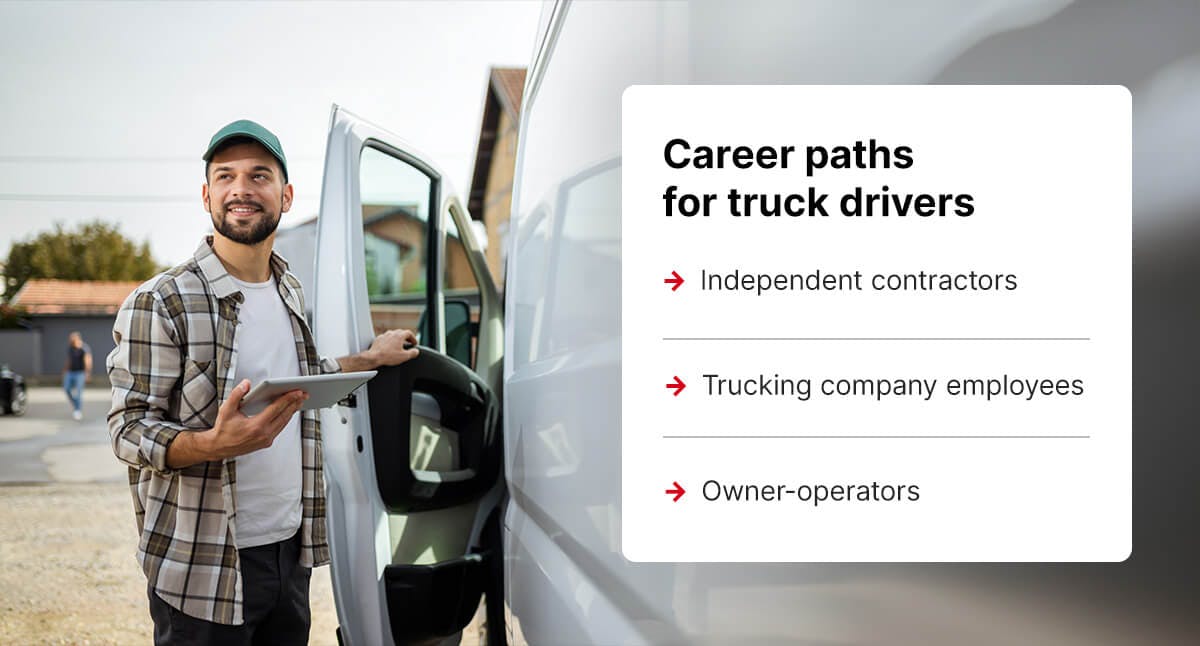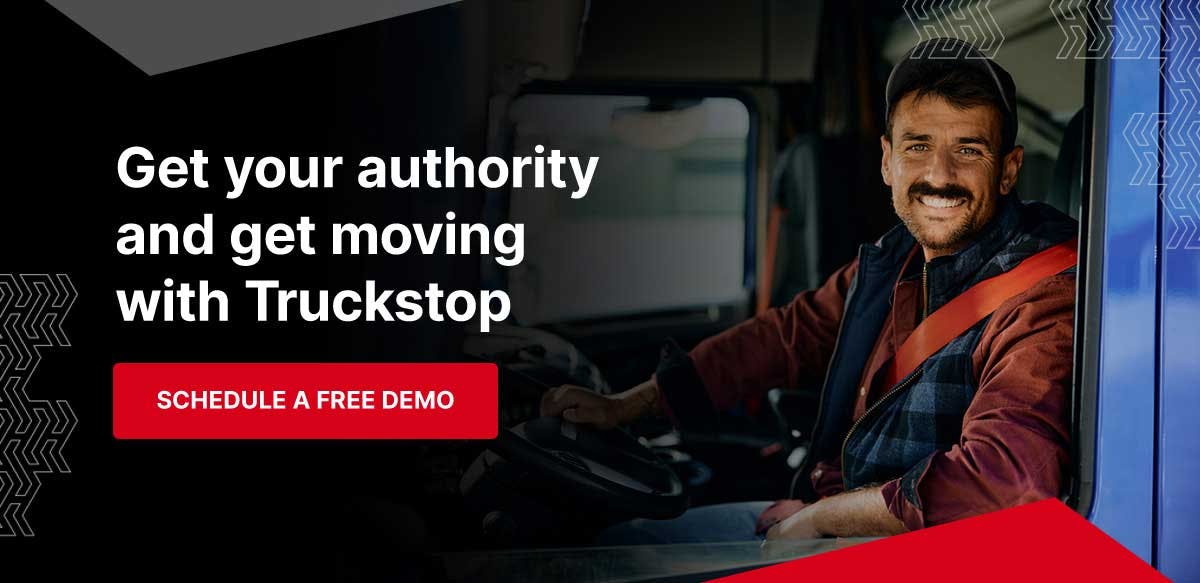8 Steps to Become a Professional Truck Driver

Listen up!
Check out our podcast, Freight Nation, where industry experts talk all things trucking.
TL;DR
Becoming a professional truck driver involves meeting minimum requirements, obtaining a commercial learner’s permit and license (CDL), gaining driving experience, and completing a finishing program. Truck drivers can be company employees or owner-operators and enjoy job security, competitive salaries, and flexible schedules.
A career in truck driving can be very rewarding. While it comes with its challenges, you can generally expect excellent job security in this industry, along with flexible work schedules and competitive salaries. If you’re interested in becoming a truck driver and want to know where to begin, you’re in the right place. Here is a guide to what you need to know to start your journey as a professional truck driver.
What does a truck driver do?
Truck drivers help keep the country’s economic engine churning by transporting goods. In addition to driving,core responsibilities include:
- Loading and unloading cargo
- Securing cargo
- Filling out paperwork for deliveries
- Performing vehicle inspections
- Keeping logs of hours worked and driving
Truck drivers also have to learn how to operate their vehicles safely under different conditions. For example, drivers need to know how to navigate steep grades to avoid brakes from overheating and how to make sure loads don’t shift when handling sharp turns.
Types of driving routes
Driving routes vary in distance, lanes, and cargo being transported. They are typically categorized as:
- Dedicated routes: Drivers run the same route regularly for a primary customer, with a consistent schedule, locations, and contacts.
- Short-haul trucking: These routes cover 150 miles or less. Short-haul truckers often complte multiple routes in a single day and spend minimal (if any) nights on the road.
- Over-the-road (OTR) trucking: OTR drivers haul freight long distances (250 miles or more), often crossing state or national borders. They might spend days or weeks on the road at a time.
What education do you need to be a truck driver?
Strictly speaking, you don’t need a formal education to become a professional truck driver. While no college degree or “higher education” is required, if you plan to work for a company, most require a high school diploma or GED. You will need to complete commercial driver’s license (CDL) training or earn a certificate of completion from an accredited truck driving school.
How to become a truck driver in 8 steps
Before you can start driving professionally, you need to complete licensing and training — and get some experience behind the wheel. Here are the eight steps to get started.
1. Meet the minimum requirements for truck driving
You’ll need to be at least 21 years old if you want to drive across state lines. In some states, drivers can get a CDL at 18 but will be limited to intrastate driving. Most companies, however, will want you to be at least 21 before hiring you.
2. Have a regular driver’s license
You will also need a valid driver’s license with few to no driving violations. Companies complete background checks when hiring, so a clean driving record will help.
3. Get your commercial learner’s permit
A commercial learner’s permit (CLP) allows you to get behind the wheel with a qualified CDL holder sitting alongside you. This helps you gain real-life experience to learn how to handle your rig. CLPs are issued by your state Department of Motor Vehicles and generally require passing a physical exam and passing written knowledge tests.

4. Get some driving experience
You may also want to attend a truck driving school to learn the best way to handle your big rig. Many community colleges offer training programs. Some companies also offer company-sponsored programs and may reimburse costs if they hire you.
5. Earn your commercial driver’s license
Obtaining a commercial driver’s license (CDL) is a multistep process and is usually completed in your home state.
The minimum requirements include:
- Be at least 18 years old (21 for interstate travel).
- Provide proof of citizenship.
- Possess a valid driver’s license.
- Have driving experience (this depends on the state but is usually at least two years).
- Have a clean driving record.
- Pass Department of Transportation (DOT) physical exams.
- Complete training approved by the Federal Motor Carrier Safety Administration (FMCSA).
- Pass a background check.
Depending on the type of truck you’ll be driving, there are classifications of CDLs that require additional steps. These include:
- Class A: Tractor-trailers (semi-trucks), tankers, flatbeds.
- Class B: Trucks not hitched to a trailer, such as box trucks or buses.
- Class C: Hazmat vehicles or vehicles that transport 16 or more passengers.
6. Get endorsements
You will need to get a Class A or Class B CDL to work as a professional truck driver. Some certifications can help you get hired faster and earn better pay.
Endorsements include:
- (H) Endorsement for transporting Hazmat loads
- (N) Endorsement for operating a tank vehicle
- (T) Endorsement for hauling double or triple trainer
- (X) Endorsement for hauling tankers or HazMat loads
7. Find a job
If you use a truck driving school or community college for training, most will assist in finding jobs after graduation. You can also use industry websites and online job boards.
8. Complete a finishing program
Most truck driving companies will want new employees to complete a driver finishing program. They want to make sure you are familiar with the vehicle you’ll be driving and any equipment you will need to do the job. This may or may not include formal training or pair you with an experienced driver as a mentor.
How long does it take to become a truck driver?
Following the steps above, you can learn how to become a truck driver with no previous experience. You can generally complete truck driver training in an average of 12 weeks. Some programs take as little as four weeks, while others span a year.
Once you have completed training and passed your tests for your CDL, some states issue them immediately, while others may take a week or two to issue your CDL by mail.
How do truck drivers get paid?
Truck drivers get paid in different ways, including:
- Hourly rate
- Pay per mile
- Salary
If you’re an owner-operator, your pay may come from load sharing — a percentage of the load. Rather than getting paid per mile or per hour, drivers earn a percentage of the revenue on loads. Some add-ons can increase what you earn depending on what’s required. For example, there may be additional pay for accessorial charges to handle things like:
- Loading and unloading trailers
- Operating forklifts or pallet jacks
- Completing after-hours deliveries
- Tarping loads or shrink-wrapping pallets
- Managing rural deliveries
You may also receive additional pay for the time you have to spend at locations for loading or unloading, or if you get stuck at a facility waiting — this is called detention pay. Some companies also provide per diem pay, which is reimbursement for your expenses like hotel stays and meals, up to a certain amount.
How much do truck drivers make?
The United States Bureau of Labor Statistics lists the average tractor-trailer truck driver’s salary at $26.92 per hour. Like most jobs, new drivers can expect to earn less when they start. More experienced drivers tend to earn more.
Pay ranges for truck drivers can vary greatly, depending on the type of truck you’re driving, the load you’re carrying, and whether you’re a company driver or an owner-operator. With the global shortage of truck drivers, pay has increased significantly over the past few years, and many companies are offering significant sign-on bonuses and incentives to new drivers.
Many drivers start out earning less while working for trucking companies and then become owner-operators once they have more experience.

Career paths for truck drivers
Once you start to gain experience, there are a few different career paths you can take in the trucking industry.
Many drivers are happy working for a company without having to worry about running their own business, while others get experience and become owner-operators to increase their pay. Either way, you’ll need to get some hours under your belt, maintain a clean driving record, and add endorsements to your CDL to enjoy higher-paying loads and progress in your career.
Independent contractors
Independent truckers are similar to owner-operators, but there are some important differences between the two. Unlike an owner-operator, independent contractors buy or lease a vehicle from a third party and work under the umbrella of a carrier as a contracted employee. In most cases, you don’t have to handle permits, fuel taxes, or load insurance since the carrier usually takes care of them.
As an independent truck driver, you will contract with one or more trucking companies or owner-operators under their DOT authority. You will generally have the freedom to choose your loads and manage your own time, and you’ll also be responsible for running your own business.
Trucking company employees
Company drivers are employees of a specific carrier. They drive a company truck, take the loads they are assigned, and get paid either by the mile or by the hour. The company typically manages expenses like fuel and maintenance. One of the biggest advantages of being a company driver is a consistent paycheck. Drivers may also be eligible for bonuses.
Being a company employee can be a great choice for drivers with specific needs, such as a family at home that relies on benefits like health insurance or consistent schedules. However, the downsides can include not being paid for the time you wait for shippers or receivers. You might not have the flexibility to get high-paying, last-minute loads, either.
Owner-operators
Deciding to be an owner-operator is about more than money. Owner-operators benefit from a flexible schedule, working for themselves, and having the opportunity to gain real business management experience. Like any self-run company, becoming an owner-operator involves a lot of responsibility.
Benefits of a career in truck driving
Becoming a truck driver can be highly fulfilling. You can enjoy job security, competitive salaries, and the freedom of flexible work schedules. Truck drivers also have the unique opportunity to travel across the country and contribute to the economy. Here are just some of the potential benefits.
- Job security and demand. The trucking industry is vital to the economy and is always in demand of skilled drivers. Many companies are actively searching, making it easier to find job opportunities and start earning a competitive income.
- Competitive salary. Truck owners can earn a solid income — especially those with experience and specialized endorsements. While the average wage is $26.92 an hour, you could potentially earn more as an owner-operator.
- Flexibility and independence. Truck drivers get to choose their own routes, especially if they’re owner-operators. This means flexible schedules and opportunities to structure your days as you like. Many drivers enjoy the independence of getting to be on the road and managing their own time.
- Travel opportunities. Truck driving allows you to explore different parts of the country — including places you might not have otherwise visited. You’ll get to experience a diversity of landscapes, cultures, and cities across the U.S. This can make the career very rewarding, especially if you enjoy traveling and new experiences.
- Career advancement opportunities. With more experience and endorsements, you can move into specialized roles or even management positions. There’s also the option to become an owner-operator, which can lead to higher earnings and the benefits of getting to run your own business.
Tips for success in truck driving
Success as a truck driver requires a combination of skills, attitude, and practical strategies. Here are some essential tips to help you thrive in this career:
- Prioritize safety: Safety should be your top priority to protect yourself, your cargo, and others on the road. Always follow safety regulations and best practices. Perform thorough pretrip inspections, follow traffic laws, and keep a safe distance from other vehicles.
- Stay organized: Keep track of your schedules, routes, and paperwork. Use digital tools or apps to manage your logs, receipts, and delivery documents efficiently. Staying organized can help you avoid delays and comply with regulations.
- Maintain communication: You’ll need strong communication skills to build relationships with dispatchers, clients, and fellow drivers. Clear communication can also help you address issues that come up during trips.
- Invest in your health: Long hours on the road can take a toll on your physical and mental well-being. Prioritize your health by eating balanced meals, exercising regularly, and getting enough rest. Consider packing healthy snacks for the road, and always stay hydrated.
- Continue learning: Stay updated on industry trends, safety regulations, and new technologies. Attend workshops, take advanced driving courses, and learn from other drivers to improve your skills and education. This can help you position yourself for further employment, increase your earning potential, and help you stay competitive in this ever-changing industry.
Following these tips can help you build a successful and fulfilling career while navigating the challenges of the road.
The business side of being an owner-operator — key considerations
Unlike company drivers who only need to worry about getting their loads to the right place at the right time, successful owner-operators have to think about the entire business side of their operations. Keep these considerations in mind when weighing the pros and cons of being an owner-operator.
- Managing finances and billing. As an owner-operator, you also wear the hats of accountant, payroll specialist, and human resources manager. Make sure you’re prepared to finance your equipment and maintenance, keep track of business expenses, stay tax-compliant with your payroll, and stay on top of invoicing your clients.
- Setting up insurance. Another important aspect of running your own trucking business is insuring yourself — and any other drivers you might bring on — and your equipment. As the owner-operator, you will be responsible for any accidents while loading, unloading, and driving, so you’ll need comprehensive coverage.
- Competing with carriers. Owner-operators have to be resourceful when it comes to finding and booking loads because, as an entrepreneur, you won’t have all the tools and systems in place that carriers do. Trucking companies have the advantage of established relationships as well, so owner-operators have to work hard to secure and keep clients.
- Negotiating for loads. Aside from competing with other drivers, owner-operators have to advocate for themselves when it comes to negotiating loads. Do you know your worth? Are you ready to fight for fair prices? You might also want to consider working with freight brokers to ensure you’re getting the best lanes for your schedule.

Get your authority and get moving with Truckstop
After you’ve worked for a while as a company driver or owner-operator, you may want to get your own trucking authority to grow your business and your income. There are several steps involved, and it can get pretty complicated, which is why Truckstop is the perfect resource for helping drivers take charge.
To thrive in the trucking industry, you need reliable access to freight and efficient management tools. The Truckstop Load Board is the perfect tool to help find profitable loads and simplify operations. It can make your day-to-day tasks easier so you can focus on the road. Start your journey to success — request your demo today!
Get helpful content delivered to your inbox.
Sign up today.
Find high-quality loads fast, get higher rates on every haul, and access tools that make your job easier at every turn.






